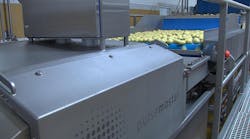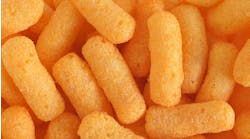The path to success for savory snacks can be as slippery as the oil they’re often fried in.
Snacks in general have been among the fastest growing of major food categories in recent years. As eating habits evolve away from the standard three-meals-a-day structure, especially among younger consumers, snacks become more of a daily habit. According to Information Resources Inc., salty snack sales in the U.S. grew 4.7%, to $19.2 billion, in the 52 weeks ending June 16.
That is basically good news for snack processors, but it also increases the pressure to conform to various expectations: healthier product, higher throughput, but with novelty and higher variety. Processing has to shoulder its share of this burden. As demand increases, putting out product quickly and reliably, while maintaining flexibility and keeping the product as wholesome as possible, becomes urgent.
“We see snack processors requiring more versatility in their systems to allow them to quickly adjust their production to meet demands of their customers, whether that may be style of snack, flavor or packaging size,” says Neil Anderson, vice president of business development for PPM Technologies, which provides processing, seasoning, conveying and other equipment for snack manufacturing and other segments of the food industry.
Although baking has been an alternative for decades, frying continues to be the mainstay of savory snacks made from potatoes, root vegetables, extruded batter and other bases. Improving fried snacks, in terms of both healthfulness and more efficient production, is largely a matter of using as little oil, and making it last as long, as possible.
The rotary fryer from PPM allowed extruded or pellet snacks to be fried for a short time on a continuous basis.
Cool it
One way to do this is to lower the frying temperature, which accomplishes several objectives: reducing the amount of oil absorbed by the product, slowing down degradation to make the oil last longer, and lowering the accumulation of acrylamide, a substance produced when foods high in starch are exposed to high heat. Acrylamide is a known carcinogen, and its levels are regulated in many jurisdictions, especially California.
Frying works in large part by driving moisture out of food. Anything that aids this process, either by making the moisture easier to remove or by reducing it before frying, will enable frying to take place at a lower temperature.
One way to make moisture easier to drive out is to fry under greatly reduced air pressure. Vacuum fryers, both batch and continuous, operate within an airtight enclosure, in which air pressure is reduced to less than 2 psi (atmospheric pressure is about 14.7). This lowers the boiling points of both the oil and the water within the chips or other snack pieces, allowing the oil to drive it out at a lower temperature.
Depending on the product, chips in a vacuum fryer can be processed at 65-85 F lower than in a conventional one. This leaves less oil in the final product, reducing calories and improving mouthfeel. It also reduces oil consumption and slows the oil’s degradation, extending the service time of oil batches.
The downsides of vacuum fryers are their size and expense, both initial and operational. Drawing a constant vacuum makes them consume considerably more energy than conventional fryers.
Taking the pulse
Another way to drive moisture out of product, allowing the oil temperature to be reduced, is to remove it before it gets into the fryer. This can be done by a technology known as pulsed electric field (PEF).
A form of pretreatment, PEF uses an electric pulse to drill minuscule holes into the cell membranes of whole potatoes or other vegetables, including beets, cassava and sweet potatoes, prior to cutting. This drives out internal liquid and the sugars it contains, reducing the potential for acrylamide formation. PEF treatment also reduces acrylamide by allowing oil temperature to be lowered from 320 F, at which acrylamide starts to form, to 300 F or less.
Pulsed Electric Field treatment, applied to whole potatoes, drives out moisture and allows frying at a lower temperature. Photo: Pulsemaster
“PEF has other benefits too,” says Mark de Boevere, managing director for PEF supplier Pulsemaster. “It makes vegetables easier to slice.” De Boevere estimates that white potatoes treated with PEF can be sliced with 40% less cutting force. This allows slicers to run longer between sharpening and leaves the vegetables with smoother surfaces, leading to less breakage and oil absorption.
PEF also is a quicker form of pretreatment than using a pre-heater, which can take up to 50 minutes. PEF takes only 30 seconds dwell time in the PEF unit. (Most of that time consists of loading and unloading the product; the actual pulse takes only about a second.)
Another way to reduce oil uptake in product is to change the molecular structure of the oil itself. This is what Eco Friendly Chef Corp. purports to do with BetterFry, a simple plate that is retrofitted into a trough or other oil cooking enclosure. BetterFry, made from silver and other proprietary rare metals, supposedly slows down the oil’s oxidation and reduces polymerization, both of which lead to breakdown, and increases its thermal conductivity, enabling shorter cook times.
The BetterFry plate can be installed at the base of the fryer, assuming there is not a conveyor there to remove debris. If there is, Eco Friendly Chef Corp. will custom-design a plate that will fit between the thermal heating tubes or electric elements, says CEO Sean Farry.
As a result, Farry says, the amount of oil absorbed by the product will be reduced 35-50%, for a drop in calorie content of 12% or more. Cooking times can be reduced by as much as 10%, and the overall amount of oil used can be reduced 12-15%, Farry says. The BetterFry plate comes with a three-year warranty, which is how long its effect lasts.
A simple way to reduce the oil takeup of fried snacks is to cook them as quickly as possible. That’s especially important with extruded snacks like cheese puffs, which have relatively little moisture once they emerge from the extruder and so can be fried quickly.
PPM has a rotary fryer designed for extruded and pellet snacks with cook times ranging from 15 to 45 seconds. “There is a carousel that has pockets,” Anderson explains. “The product is collected in a pocket and carried through the oil. You adjust the speed of the carousel to vary the cooking time, the design is continuous only and has a maximum cooking time of 45 seconds.”
Spice is variety
Cooking is of course not the only consideration in snack production. A major part of the operation is application of powdered seasonings, which has to be done consistently, cleanly and without waste.
Seasoning powder is a particularly messy ingredient that penetrates into crevices and is hard to clean up. This has implications for food safety and for efficiency, especially if a processor has to make frequent shifts in flavors.
The drums that toss snack pieces to allow them to be seasoned are the primary focus of cleanup. There has been a trend toward plastic drums, which are cheaper than stainless steel. However, plastic drums have a long-term disadvantage in sanitation, says Trevor Howard, managing director of Fabcon Food Systems.
“We are seeing a growing reluctance by major retailers, particularly in the UK, to accept potato chips and snack products seasoned using plastic drums,” Howard says. “This is due to abrasive products causing damage from scratching to the inside of the drum, leading to cleaning and bacterial issues. As a result of that, we are seeing much more demand for conventional stainless-steel drums.”
To accommodate processors who make frequent shifts in flavors, Fabcon offers On-Machine Seasoning, in which each weighing and packaging station has its own mini-seasoning system. This allows several flavors to be run simultaneously on multiple bag-filling lines.
Snacks, as much (or more) than other major food segments, have to be as versatile as possible to produce, and as healthy as possible to consume. Current technologies can help processors meet those goals as efficiently as possible.


